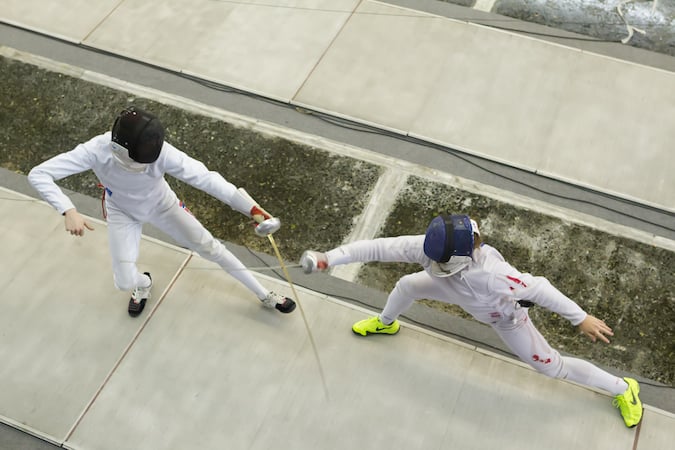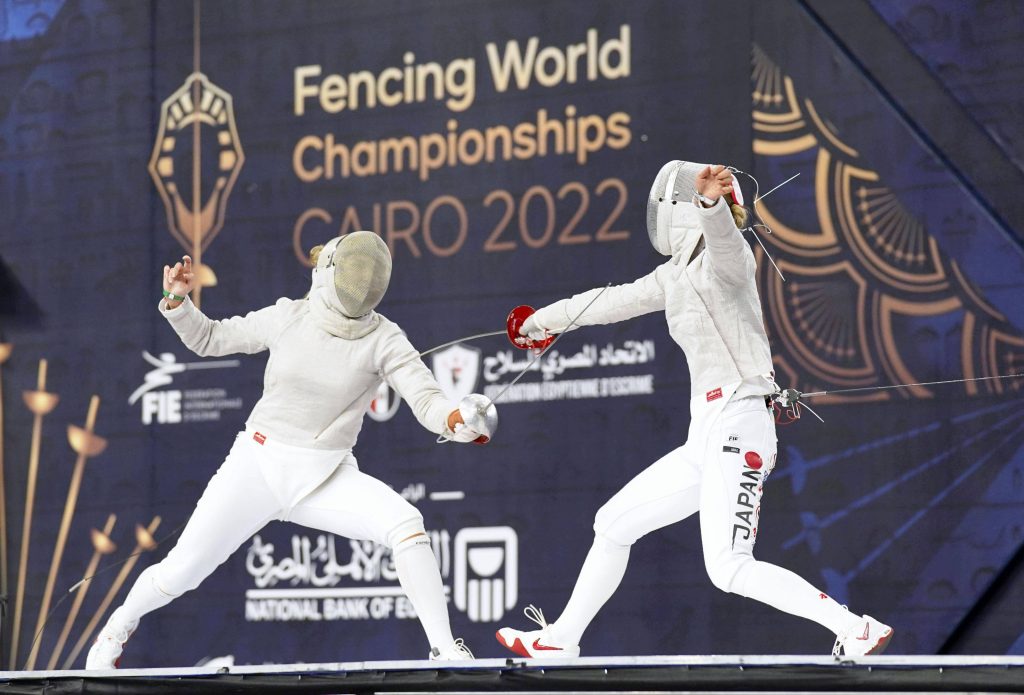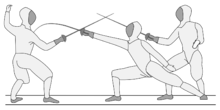Fencing is a sport that requires quick reflexes, agility, and strategic thinking. One of the most important techniques in fencing is the forward move, which allows fencers to close the distance between themselves and their opponent while maintaining control and balance. Mastering the forward move can give fencers an edge in competition and help them score points against their opponents. In this blog post, we will explore the different aspects of the forward move in fencing, including techniques, training drills, and strategies.
Understanding the Forward Move in Fencing

The forward move in fencing is a basic technique used to advance towards your opponent while maintaining a defensive position. It involves taking small, controlled steps with the front foot while keeping the back foot planted firmly on the ground. This movement allows fencers to cover ground quickly and efficiently while staying balanced and ready to defend or attack.
There are two types of forward moves in fencing: the advance and the lunge. The advance is a simple step forward with the front foot, while the lunge is a more dynamic movement where the front leg extends forward and the back leg pushes off the ground, propelling the fencer towards their opponent. Both of these movements require proper form and technique to be effective.
To execute a successful forward move, fencers must maintain a low center of gravity and keep their body weight evenly distributed between their front and back legs. This allows for quick changes in direction and helps fencers stay balanced and in control. Additionally, fencers must keep their arms extended and their weapon pointed towards their opponent, ready to attack or defend at any moment.
Mastering the Technique of the Forward Move in Fencing

Mastering the technique of the forward move in fencing takes time and practice. It requires a combination of physical strength, coordination, and mental focus. Here are some tips to help you improve your forward move technique:
Proper Footwork
As mentioned earlier, proper footwork is crucial for a successful forward move in fencing. Fencers must maintain a low center of gravity and keep their weight evenly distributed between their front and back legs. This allows for quick changes in direction and helps fencers stay balanced and in control.
In addition to the footwork itself, it’s important to pay attention to the placement of your feet. Your front foot should be pointed towards your opponent, while your back foot should be at a 90-degree angle to your front foot. This stance allows for maximum power and balance when executing the forward move.
Core Strength and Control
The forward move requires a strong core and good control over your body. To improve your core strength, incorporate exercises such as planks, Russian twists, and bicycle crunches into your training routine. These exercises will help you maintain a stable and balanced position while executing the forward move.
Furthermore, practicing balance exercises such as standing on one leg or using a balance board can also help improve your control and stability during the forward move.
Mental Focus
Fencing is not just a physical sport, but also a mental one. To execute a successful forward move, fencers must have a clear mind and be able to anticipate their opponent’s movements. This requires mental focus and concentration.
To improve your mental focus, try incorporating meditation or visualization techniques into your training routine. These practices can help you stay calm and focused during a match, allowing you to execute the forward move with precision and accuracy.
The Importance of the Forward Move in Fencing

The forward move is an essential technique in fencing for several reasons. Firstly, it allows fencers to close the distance between themselves and their opponent, making it easier to score points. Secondly, it helps fencers maintain a defensive position while advancing towards their opponent, making it more difficult for their opponent to attack. Lastly, the forward move is a versatile technique that can be used in various situations, making it an important tool in a fencer’s arsenal.
Common Mistakes to Avoid when Executing the Forward Move in Fencing

While the forward move is a crucial technique in fencing, there are some common mistakes that fencers make when executing it. These mistakes can hinder their performance and leave them vulnerable to their opponent’s attacks. Here are some common mistakes to avoid when performing the forward move:
Overextending the Front Leg
One of the most common mistakes in the forward move is overextending the front leg. This happens when fencers push too far with their front leg, causing them to lose balance and become vulnerable to attacks. To avoid this mistake, focus on taking small, controlled steps with your front foot and keeping your weight evenly distributed between your legs.
Not Maintaining a Low Center of Gravity
As mentioned earlier, maintaining a low center of gravity is crucial for a successful forward move. However, many fencers tend to stand too upright, making it difficult for them to change direction quickly and maintain balance. To avoid this mistake, focus on keeping your body low and your weight evenly distributed between your legs.
Lack of Coordination
The forward move requires coordination between the upper and lower body. Many fencers struggle with this aspect, leading to a lack of control and balance during the movement. To improve coordination, practice drills that involve both upper and lower body movements, such as lunges with arm extensions or footwork drills with weapon movements.
Training Drills to Improve Your Forward Move in Fencing
To master the forward move in fencing, it’s essential to incorporate specific training drills into your routine. These drills can help you improve your technique, coordination, and overall performance. Here are some training drills to help you improve your forward move in fencing:
Footwork Drills
Footwork drills are an essential part of any fencing training routine. They help fencers improve their footwork, coordination, and balance. Here are two footwork drills that can help you improve your forward move:
- Advance and Retreat Drill: This drill involves taking small steps forward and backward, focusing on maintaining a low center of gravity and proper foot placement. You can also add variations to this drill, such as incorporating lunges or changing direction quickly.
- Lunge Drill: This drill focuses on improving the lunge movement in the forward move. Start by standing in a lunge position with your front leg extended and your back leg bent. From this position, practice extending and retracting your front leg while maintaining balance and control.
Coordination Drills
As mentioned earlier, coordination is crucial for a successful forward move in fencing. Here are two coordination drills that can help you improve your technique:
- Mirror Drill: This drill involves facing a partner and mirroring their movements. One person leads, and the other follows, mimicking their footwork and weapon movements. This drill helps improve coordination and reaction time.
- Footwork and Weapon Movement Drill: This drill combines footwork and weapon movements to improve coordination and control. Start by practicing footwork movements while holding your weapon in the en garde position. Then, add weapon movements such as extensions, disengages, and beats while maintaining proper footwork.
Strategies for Incorporating the Forward Move into Your Fencing Style
The forward move is a versatile technique that can be incorporated into various fencing styles. Here are some strategies for using the forward move effectively in different situations:
Offensive Strategy
In an offensive strategy, the forward move is used to close the distance between yourself and your opponent and score points. To execute this strategy effectively, focus on maintaining a low center of gravity and using quick, controlled steps to advance towards your opponent. Additionally, use feints and changes in direction to catch your opponent off guard and create openings for attacks.
Defensive Strategy
In a defensive strategy, the forward move is used to maintain a safe distance from your opponent while still being able to attack. To execute this strategy, focus on keeping your weight evenly distributed between your legs and using small, controlled steps to retreat from your opponent’s attacks. Additionally, use lunges or quick changes in direction to counter your opponent’s attacks.
The Role of Footwork in a Successful Forward Move in Fencing
Footwork is an essential aspect of fencing, and it plays a crucial role in executing a successful forward move. Here are some ways footwork contributes to a successful forward move:
- Balance and Control: Proper footwork allows fencers to maintain balance and control during the forward move, making it easier to change direction and react to their opponent’s movements.
- Speed and Agility: Quick footwork is essential for a successful forward move. It allows fencers to cover ground quickly and efficiently, making it easier to close the distance between themselves and their opponent.
- Versatility: Good footwork allows fencers to adapt to different situations and incorporate the forward move into their fencing style effectively.
How to Counter Your Opponent’s Forward Move in Fencing
Knowing how to counter your opponent’s forward move can give you an advantage in a match. Here are some strategies to help you counter your opponent’s forward move:
- Parry and Riposte: This technique involves deflecting your opponent’s attack with your weapon and immediately following up with a counterattack. To execute this effectively, pay attention to your opponent’s movements and anticipate their forward move.
- Retreat and Attack: If your opponent is using the forward move to close the distance between you, you can retreat and then launch a surprise attack as they come towards you. This strategy requires quick reflexes and good footwork.
- Counter Lunge: If your opponent is using the lunge in their forward move, you can use a counter lunge to deflect their attack and score a point. This technique requires good timing and coordination.
The Mental Aspect of the Forward Move in Fencing
As mentioned earlier, fencing is not just a physical sport, but also a mental one. The same applies to the forward move. Here are some ways the mental aspect plays a role in executing a successful forward move:
- Focus and Concentration: To execute the forward move with precision and accuracy, fencers must have a clear mind and be able to anticipate their opponent’s movements. This requires focus and concentration.
- Confidence: Having confidence in your abilities and your forward move technique can give you an edge in a match. It allows you to execute the movement without hesitation and with full commitment.
- Adaptability: Being mentally flexible and adaptable allows fencers to adjust their forward move technique based on their opponent’s movements and style. This can help them stay one step ahead and make quick decisions during a match.
Advanced Techniques for Executing the Forward Move in Fencing
Once you have mastered the basic technique of the forward move, you can start incorporating more advanced techniques into your repertoire. These techniques require a higher level of skill and coordination, but they can give you an advantage over your opponents. Here are two advanced techniques for executing the forward move in fencing:
- Fleche: The fleche is a dynamic and explosive movement that involves launching yourself towards your opponent with a lunge while keeping your weapon extended. This technique requires good timing and coordination, but it can catch your opponent off guard and score points.
- Balestra: The balestra is a combination of the advance and lunge movements. It involves taking a small step forward with the front foot and then immediately following up with a lunge. This technique can be used to close the distance between you and your opponent quickly and launch a surprise attack.
Conclusion
The forward move is an essential technique in fencing that requires a combination of physical strength, coordination, and mental focus. Mastering this technique takes time and practice, but it can give fencers an edge in competition and help them score points against their opponents. By understanding the technique, avoiding common mistakes, and incorporating training drills and strategies into your routine, you can improve your forward move and take your fencing skills to the next level. Remember to always stay focused, maintain proper footwork, and be adaptable to your opponent’s movements. With dedication and hard work, you can become a master of the forward move in fencing.